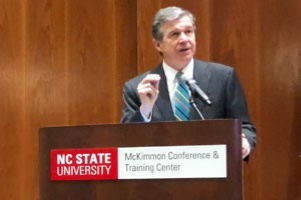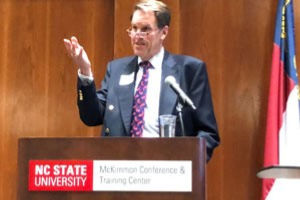Opportunity Zone Programs Bring Investors and Communities Together
UPDATE (12/7/2022)
Click Here To See Updated High Point Opportunity Zones
By Community Development and Corporate Communications
 Recently, panelists of the 38th Annual Economic Outlook Conference discuss the use of Opportunity Zones in attracting business investments in low-income communities.
Recently, panelists of the 38th Annual Economic Outlook Conference discuss the use of Opportunity Zones in attracting business investments in low-income communities.
Addressing the economic inequalities at play in low-income and underserved communities is of particular importance to our Community Development team, who convene business, government and community leaders to discuss a myriad of economic issues impacting our Richmond Fed communities.
One topic gaining attention are Opportunity Zones, a relatively new investment approach to transforming low-income and underserved communities. OZs are low-income census tracts where tax incentives may accrue to those who invest and hold their capital gains in OZ assets or property. Created as part of The Tax Cuts and Jobs Act passed by Congress in December 2017, OZs are a new federal economic development tool to improve the outcomes of distressed communities around the country. They offer tax incentives to draw long-term investment to parts of America that continue to struggle with high poverty and sluggish job and business growth, while a disproportionate share of economic growth has been concentrated in so-called superstar metropolitan areas or “hot spots.”
“This concept, Opportunity Zones, was originally introduced in the Investing in Opportunity Act (IIOA), and is the first new community development tax incentive program for private capital in low-income communities since the creation of the New Markets Tax Credit (NMTC) in 2000,” said Richmond Fed’s Jeanne Milliken Bonds, senior manager, Regional Community Development.
Our Community Development team recently convened two technical discussions on OZs in South Carolina and in North Carolina where investments are moving forward. The 38th Annual Economic Outlook Conference was held December 4 in Columbia, South Carolina, at the University of South Carolina’s Darla Moore School of Business. The North Carolina Opportunity Zones General Convening and Community Workshop was held December 13 at North Carolina State University in Raleigh, North Carolina. “Every state in the U.S. has a rural-urban divide. The difference is that we are doing something about it [now],” North Carolina Governor Roy Cooper told more than 300 people who gathered in Raleigh.
What are Opportunity Zones?
 OZ investment occurs through a Qualified Opportunity Fund (QOF), an investment vehicle taxed as a corporation or a partnership for the purpose of investing in Qualified Opportunity Zone Property (QOZP). It must hold at least 90 percent of its assets in QOZP and self-certifies using IRS Form 8996 (presently, still a draft form). The U.S. Treasury defines and certifies QOFs. There are four investment types: Commercial Real Estate Development and Renovation; New Businesses; Expansion of Existing Business into Opportunity Zones; and Large Expansions of Businesses in Opportunity Zones.
OZ investment occurs through a Qualified Opportunity Fund (QOF), an investment vehicle taxed as a corporation or a partnership for the purpose of investing in Qualified Opportunity Zone Property (QOZP). It must hold at least 90 percent of its assets in QOZP and self-certifies using IRS Form 8996 (presently, still a draft form). The U.S. Treasury defines and certifies QOFs. There are four investment types: Commercial Real Estate Development and Renovation; New Businesses; Expansion of Existing Business into Opportunity Zones; and Large Expansions of Businesses in Opportunity Zones.
U.S. investors receive a temporary capital gains deferral and other tax benefits, including partial forgiveness and forgiveness of additional gains when they reinvest unrealized capital gains into Opportunity Funds for a minimum of five years. The QOFs invest in qualified OZ property and businesses. Some communities active in recruiting investment are hoping that OZs will gain attention following a presidential executive order executed in Washington, D.C., on December 12, which establishes a White House Opportunity and Revitalization Council. The Council will be chaired by the secretary of housing and urban development, and comprised of 13 federal agencies.
Where are the Opportunity Zones?
The state governors or chief executive of states, districts or territories were involved in designating opportunity zones in March 2018. All 50 states, the District of Columbia and U.S. territories were eligible to designate these tracts from a pool of low-income, high-poverty census tracts and subject to certification by the secretary of the U.S. Treasury.
More than 8,700 census tracts located in each state, the District of Columbia and U.S. territories have been designated — approximately 11 percent of the country by census tract. A list of all zones, as well as a mapping tool, are available at CDFI Fund.gov. In the Fifth District, 828 tracts have been certified. The zones are urban, rural and suburban, and were made based on different formulas for areas with investment in pipeline as well as areas with disinvestment. The Urban Institute Opportunity Zones Investment Score Dataset notes the score of different Opportunity Zones.
- North Carolina Opportunity Zones (252 census tracts)
- South Carolina Opportunity Zones (135 census tracts)
- Virginia Opportunity Zones (212 census tracts)
- West Virginia Opportunity Zones (55 census tracts)
- Maryland Opportunity Zones (149 census tracts)
- D.C. Opportunity Zones (25 census tracts)
“There are certain inherent risks to low-income communities because there is potential for a massive influx of capital, with few guardrails, which could exacerbate the disparity between investable hot spots and deserts across the country,” explained Bonds. “Concentrating investments can lead to higher costs, and possibly displacement of existing community development investments so part of the discussion includes how to mitigate these risks and discuss practices that are potentially beneficial to investor and community alike.”
What’s next?
A Treasury Guidance Request was issued in late November for additional comments on several topics that were not covered by the Proposed Regulations and Revenue Ruling issued earlier in October.
Resources
- The Fundamentals of Opportunity Zones: Investing in Opportunity Act “IIOA” 2017 Tax Cuts and Jobs Act
- What you need to know about Opportunity Zones
- What is an “investment ready” real estate project, and how do you get there? (Examples: Silo Ridge; Louisville University adjacent)
- Balancing Investor Perspectives with Community Needs
- The 38th Annual Economic Outlook Conference
- The 38th Annual Economic Outlook Conference Program
IRS - Opportunity Zones - Frequently Asked Questions
Opportunity Zones - High Point Map
Development Incentive Program
The purpose of the Development Incentive Grant is to encourage rehabilitation of older buildings and/or promote infill growth with new commercial development in High Point’s Downtown Municipal Service District.
Download Development Incentive Grant Document